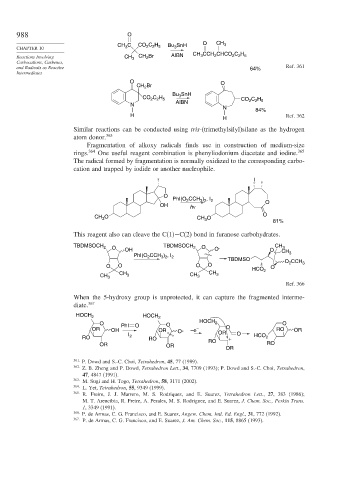Page 1012 - Advanced Organic Chemistry Part B - Reactions & Synthesis
P. 1012
988 O
CH C CO C H Bu SnH O CH 3
2 2 5
CHAPTER 10 3 3
2
2 2 5
Reactions Involving CH 3 CH Br AIBN CH 3 CCH CHCO C H
2
Carbocations, Carbenes,
and Radicals as Reactive 64% Ref. 361
Intermediates
O O
CH 2 Br
Bu SnH
C H 3
CO 2 2 5 CO C H
AIBN 2 2 5
N
N
84%
H Ref. 362
H
Similar reactions can be conducted using tris-(trimethylsilyl)silane as the hydrogen
atom donor. 363
Fragmentation of alkoxy radicals finds use in construction of medium-size
rings. 364 One useful reagent combination is phenyliodonium diacetate and iodine. 365
The radical formed by fragmentation is normally oxidized to the corresponding carbo-
cation and trapped by iodide or another nucleophile.
I
O
PhI(O 2 CCH 3 ) 2 , I 2 O
OH hν
CH 3 O CH 3 O O
81%
This reagent also can cleave the C(1)−C(2) bond in furanose carbohydrates.
O .
TBDMSOCH 2 TBDMSOCH 2 O CH 3
OH O O
CH 3
PhI(O 2 CCH 3 ) 2 , I 2
TBDMSO
O 2 CCH 3
O O O O O
HCO 2
CH 3 CH 3 CH 3
CH 3
Ref. 366
When the 5-hydroxy group is unprotected, it can capture the fragmented interme-
diate. 367
HOCH 2 HOCH 2
HOCH
O PhI O O 2 O
OR OH OR O . –e – O RO OR
I OR O HCO
RO 2 RO RO + 2
OR OR RO
OR
361
P. Dowd and S.-C. Choi, Tetrahedron, 45, 77 (1989).
362 Z. B. Zheng and P. Dowd, Tetrahedron Lett., 34, 7709 (1993); P. Dowd and S.-C. Choi, Tetrahedron,
47, 4847 (1991).
363
M. Sugi and H. Togo, Tetrahedron, 58, 3171 (2002).
364
L. Yet, Tetrahedron, 55, 9349 (1999).
365 R. Freire, J. J. Marrero, M. S. Rodriquez, and E. Suarez, Tetrahedron Lett., 27, 383 (1986);
M. T. Arencibia, R. Freire, A. Perales, M. S. Rodriguez, and E. Suarez, J. Chem. Soc., Perkin Trans.
1, 3349 (1991).
366 P. de Armas, C. G. Francisco, and E. Suarez, Angew. Chem. Intl. Ed. Engl., 31, 772 (1992).
367
P. de Armas, C. G. Francisco, and E. Suarez, J. Am. Chem. Soc., 115, 8865 (1993).

